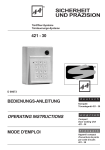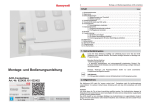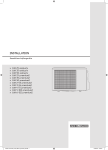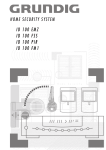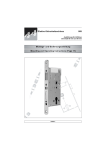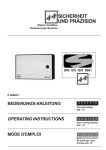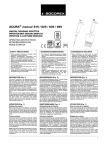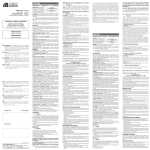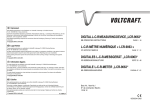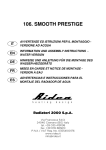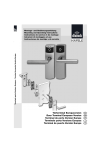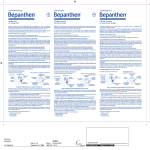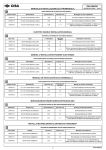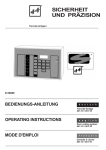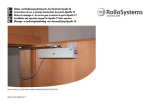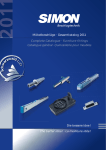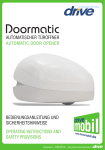Download Bedienungs-Anleitung Codeschloss 495-10/-11
Transcript
® SICHERHEIT UND PRÄZISION Türöffner-Systeme Türsteuerungs-Systeme D 00082 BEDIENUNGS-ANLEITUNG deutsch Seite 2 Codeschloß 495-10 / 495-11 OPERATING INSTRUCTIONS english Page 7 Code lock 495-10 / 495-11 MODE D'EMPLOI Page 12 ISTRUZIONI PER L'USO Pag. 17 français Serrure à combinaison digitale 495-10 / 495-11 italiano serratura a combinazione digitale 495-10 / 495-11 Lieber effeff- Kunde, wir beglückwünschen Sie zu Ihrem Codeschloß und danken Ihnen für das Vertrauen, das Sie mit Ihrer Wahl dem Fabrikat effeff Fritz Fuss entgegenbringen. Wir sind überzeugt, daß dieses Codeschloß Ihre Erwartungen erfüllen wird. Bitte lesen Sie unbedingt vor der Montage bzw. Inbetriebnahme die allgemeinen Hinweise, damit Sie sich mit der Handhabung des effeff-Codeschlosses vertraut machen können. Richtige Handhabung und sachgemäße Pflege sind die Voraussetzung für die hohe Lebensdauer und ständige Betriebsbereitschaft des Gerätes. Vorbereitung für die Codeschloßmontage Da die Länge des Schließzylinders im vorhandenen Türschloß für diesen Codeschloßbeschlag nicht mehr ausreicht, muß in der ersten Umbauphase zunächst ein passender Schließzylinder eingebaut werden. Um die Schließzylinderlänge zu bestimmen, haben wir auf Seite 23 eine Hilfsskizze abgebildet. Diese Schließzylinder (nicht im Lieferumfang enthalten), lassen sich durch den örtlichen Fachhandel besorgen. Der Codeschloß-Drückervierkant ist für Standard-Türschlösser mit einer Türdrückernuß von 8 mm vorgesehen. Für die Türdrückernuß-Maße 8,5 mm und 9 mm liegen dem Montage-Zubehör spezielle Reduzierungshülsen bei. Umrüstung an bestehenden Türen Der Codeschloßbeschlag ist nur an Türen montierbar, deren Schlösser ein Dornmaß von mindestens 55 mm aufweisen (Seite 24). Vorhandene Beschlägegarnitur, Drückervierkant und Zylinder ab- bzw. ausbauen. Neuen Schließzylinder ausmessen und einbauen (Skizze Seite 23). Montage an neuen Türen Standard-Türschloß mit einem Entfernungsmaß von 72 mm und einem Dornmaß nicht unter 55 mm einbauen. Lauten die Bestellangaben über ein anderes Entfernungsmaß, so liegen dem Montagezubehör entsprechende Zylinderplatten bei. Neuen Schließzylinder ausmessen und einbauen. Das Codeschloß wird zunächst auf der, der endgültigen Montageseite gegenüberliegenden Türblattseite, aufgesteckt (Innenseite). Bohrschablone an der Außenseite der Tür aufsetzen und durch Zylinder und Drückervierkant ausrichten. Eine weitere Fixiermöglichkeit ist das Ausrichten durch die auf der Schablone aufgedruckte Dornmaßeinteilung. Hierbei wird bei dem durch das eingebaute Schloß vorgegebenen Dornmaß die entsprechende Dornmaßeinteilung auf der Scha2 deutsch blone abgeschnitten. Dadurch kann die Schablone exakt auf der Tür ausgerichtet und mit Klebestreifen befestigt werden. Bei überfälzten Türen muß die Breite des Überschlages beachtet werden. Holztüren Bohrpunkte markieren und danach Bohrschablone und Codeschloß von der Tür entfernen. Direktes Durchbohren der Tür mittels Holzbohrer Ø 10 mm für Codeschloßbefestigungsschrauben M 5 und Ø 16 mm für das Batterieanschlußkabel (Seite 25). Metalltüren Bohrpunkte markieren und danach Bohrschablone und Codeschloß von der Tür entfernen. Direktes Durchbohren der Tür mittels Metallbohrer Ø 6 mm (lange Metallbohrer verwenden, Seite 26). Mit Aufschälbohrer an der Außenseite der Tür Codeschloßbefestigungsbohrungen auf Ø 10 mm aufweiten. Die Bohrung für das Batterieanschlußkabel muß an der Türinnenseite sowie an der Türaußenseite auf Ø 16 mm aufgeweitet werden. Bei Blechtüren dürfen die Verbindungsschrauben M 5 nicht zu fest angezogen werden, da sich sonst die Tür im Schloßbereich verformen kann. Fertigmontage Aufsetzen des Codeschloß-Außenbeschlages Aufsetzen des Codeschloß-Innenbeschlages Verschrauben der Codeschloßbeschläge: Jeder Verpackungseinheit liegen 4 x 2 Codeschloß-Beschlägeschrauben bei. Die Länge der Befestigungsschrauben orientiert sich nach der Türblattstärke und nach dem bestellten Codeschloß-Typ. Codeschloß Best.Nr. 495-10 Türblattstärken 38-50 mm 495-11 50-70 mm Beschlag oben Beschlag unten 2 St.M 5x80 2 St.M 5x65 2 St.M 5x55 2 St.M 5x45 Aufstecken und Verschrauben der Türdrücker Bevor die beiliegenden 4 Kunststoffabdeckhüllen für die Codeschloß-Montagebohrungen aufgesteckt werden, sollte das Codeschloß in Betrieb genommen werden (siehe Inbetriebnahme und Programmierung). Inbetriebnahme und Programmierung Vor der Erstinbetriebnahme des elektrischen Codeschlosses muß ein 9 Volt Batterieblock in das Codeschloß eingesetzt werden. Hierzu muß das Batteriefach seitlich am Innen3 schild des Codeschlosses mit einem Schraubendreher geöffnet werden, um die Batterie auf den Anschlußclip zu stecken. Der Batterieblock ist nicht im Lieferumfang des Codeschlosses enthalten. Batterien die zur Auswahl stehen: 9 Volt Lithium-Batterieblock (Betriebszeit ca. 2 Jahre, bei täglich ca. 15 Betätigungen) 9 Volt Standard-Batterieblock (Betriebszeit ca. 1 Jahr, bei täglich ca. 15 Betätigungen) 9 Volt Akku-Block Funktionsprüfung Einschalten der Betriebsbereitschaft durch Betätigung der Taste E auf der Folientastatur. Die grüne LED-Anzeige blinkt zweimal kurz auf als Eingabebereitschaftsanzeige. Initialisierungscode O eingeben (werkseitige Grundeinstellung, auch nach Geräte-Reset). Die Tür bzw. der Türdrücker wird für 3 Sek. zur Betätigung (zum Öffnen der Tür) freigegeben. Während der Türentriegelungszeit kann der Türdrücker nur einmal betätigt werden. Ist die Türentriegelungszeit von 3 Sek. abgelaufen, ohne daß die Tür geöffnet wurde, so ist der Türdrücker wieder verriegelt. Sollte das Codeschloß nach der Programmierung oder dem Batteriewechsel nicht ordnungsgemäß funktionieren, so muß der Batterieclip nochmals kurzzeitig von der Batterie abgezogen werden (kurzzeitige Trennung der Stromversorgung). Führt dies nicht zum Erfolg, siehe unter Störung-Reset. Programmierung mit Eingabezeitlimit Bei der Programmierung ist unbedingt darauf zu achten, daß nach jeder Betätigung einer Taste auf der Folientastatur nicht länger als 5 Sek. verweilt werden darf. Erstprogrammierung des Änderungscodes bzw. Neufestlegung des Änderungscodes nach einem Reset Einschalten der Betriebsbereitschaft durch Betätigung der Taste E auf der Folientastatur. Die grüne LEDAnzeige blinkt zweimal kurz auf als Eingabebereitschaftsanzeige. Initialisierungscode O eingeben. Durch Drücken der Taste P Programmiermodus einschalten. Gewünschten Änderungscode über die Folientastatur eingeben. Zur Auswahl steht eine beliebige Codezahl von mind. 2 bis max. 6 Codeziffern. Durch Drücken der Taste P Eingabe bestätigen. Beispiel: E O P 1234 P = Änderungscode E 1234 4 deutsch Neufestlegung des Änderungscodes Einschalten der Betriebsbereitschaft durch Betätigung der Taste E auf der Folientastatur. Die grüne LED-Anzeige blinkt zweimal kurz auf als Eingabebereitschaftsanzeige. Aktuellen Änderungscode eingeben. Durch Drücken der Taste P Programmiermodus einschalten. Gewünschten neuen Änderungscode über die Folientastatur eingeben. Zur Auswahl steht eine beliebige Codezahl von min. 2 bis max. 6 Codeziffern. Durch Drücken der Taste P Eingabe bestätigen. Beispiel: E 1234 P 4321 P = neuer Änderungscode E 4321 Programmierung der Benutzercode Zur Bedienung des Codeschlosses stehen 3 freiprogrammierbare Benutzercodes zur Verfügung. Die Festlegung erfolgt durch die Plazierungsangabe 1, 2 oder 3 ( sehen Sie hierzu unser Beispiel). Die 1. Codeziffer der zu programmierenden Benutzercodes darf auf keinen Fall mit der 1.Codeziffer des Änderungscodes übereinstimmend programmiert werden. Einschalten der Betriebsbereitschaft durch Betätigung der Taste E auf der Folientastatur. Die grüne LEDAnzeige blinkt zweimal kurz auf als Eingabebereitschaftsanzeige. Aktuellen Änderungscode eingeben. Durch Drücken der Taste P Programmiermodus einschalten. Gewünschte Plazierung des Benutzercodes eingeben (Ziffer 1 = Erster Benutzercode). Durch Drücken der Taste P Eingabe bestätigen. Gewünschten Benutzercode eingeben. Zur Auswahl steht eine beliebige Codezahl bis max. 6 Codeziffern. Durch Drücken der Taste P Eingabe bestätigen. Die Programmierung eines evtl. zweiten oder dritten Benutzercodes muß nach dem vorgenannten Prinzip erfolgen (sehen Sie hierzu unser Beispiel). Beisp.: E 4321 P 1 P 78493 P = 1. Benutzercode E 78493 E 4321 P 2 P 539 P = 2. Benutzercode E 539 E 4321 P 3 P 7431 P = 3. Benutzercode E 7431 Bedienung des Codeschlosses (max. Eingabezeit 13 Sek.) Einschalten der Betriebsbereitschaft durch Betätigung der Taste E auf der Folientastatur. Die grüne LED-Anzeige blinkt zweimal kurz auf als Eingabebereitschaftsanzeige. Aktuellen Benutzercode eingeben (eine der drei programmierten Benutzercodes). Die Tür bzw. der Türdrücker wird für 3 Sek. zur Betätigung (zum Öffnen der Tür) freigegeben. Während der Türentriegelungszeit kann der Türdrücker nur einmal betätigt werden. Ist die Türentriegelungszeit von 3 Sek. abgelaufen, ohne daß die Tür geöffnet wurde, so ist der Türdrücker wieder verriegelt. 5 Falscheingaben von Codezahlen - Sperrzeit 13 Sek. Wird eine falsche Codezahl eingegeben, erfolgt keine Freigabe der Tür. Desweiteren wird die Folientastatur für 13 Sek. elektronisch gesperrt (Sperrzeit). Erst nach Ablauf dieser Sperrzeit ist wieder eine komplett neue Eingabe möglich (siehe Bedienung des Codeschlosses). Batteriewechsel Bei weitgehend verbrauchter Batteriekapazität (noch ca. 50 Betätigungen möglich), blinkt während der Türentriegelungszeit von 3 Sek. eine rote LED-Anzeige auf der Folientastatur auf. Diese Anzeige weist den Nutzer/Betreiber auf die Notwendigkeit eines umgehenden Batteriewechsels hin. Die gespeicherte aktuelle Codezahl bleibt während des Batteriewechselvorgangs erhalten. Störung-Reset Für den Gerätestörfall oder bei Verlust der Codezahl besteht die Möglichkeit eines Geräte-Resets (beachten Sie Seite 22). Hierzu muß der äußere Codeschloßbeschlag abmontiert werden, um auf der Codeschloß-Rückseite (Außenschild) einen Reset-Taster bedienen zu können. Zunächst muß (bei angeschlossener Batterie) auf der Tastatur die E Taste gedrückt werden und anschließend innerhalb von 13 Sek. der vorgenannte Reset-Taster. Nach diesem Vorgang muß das Codeschloß wieder montiert werden. Durch diesen Reset-Vorgang ist das Codeschloß wieder auf die werkseitige Grundeinstellung programmiert. Die weitere Bedienung wird im Abschnitt Funktionsprüfung erklärt. Bitte beachten Sie: Während der Codeeingabe darf der Türdrücker des Codeschlosses nicht betätigt werden. Die Folientastatur des Codeschlosses darf ausschließlich nur manuell betätigt werden (auf keinen Fall mit Gegenständen wie z.B. Schlüssel, Schreibstiften etc.) Pflegehinweise: Das Codeschloß darf nur mit einem feuchten Lappen und mit nichtkratzenden, milden Putzmitteln gereinigt werden. Vermeiden Sie das Eindringen von Feuchtigkeit in die Codeschloßbeschläge. Für das hier beschriebene effeff-Produkt gelten die Garantiebedingungen der Firma Fritz Fuss GmbH & Co., Albstadt Technische Änderungen vorbehalten. 6 english Dear effeff client, May we congratulate you on your code lock and thank you for the trust you have placed in effeff Fritz Fuss in selecting this brand. We are convinced that this code lock will meet your expectations. It is essential that you read the general instructions prior to initial operation, in order that you are able to familiarize yourself with the handling of the effeff code lock. Correct handling and proper care are prerequisites for a long service life and the constant operational readiness of the equipment. Preparations prior to fitting the code lock As the length of the lock cylinder in the existing door lock is no longer sufficient for the code lock’s hardware, the first conversion step must be to install a suitable lock cylinder. As an aid there is a sketch on page 23 for the purpose of determining the lock cylinder’s length. These lock cylinders (not supplied by us) are obtainable from your local lock smith shop. The code lock’s spindle for the handle is envisaged for standard door locks with a follower width of 8 mm. Special reduction bushes are enclosed with the installation accessories for the follower width of 8.5 mm and 9 mm. In order to fit two cylinder plates to the code lock 8 countersunk head screws M4 x 8 mm are included with the installation accessories. Conversion of existing doors The code lock hardware is only fittable to doors whose locks have a backset of at least 55 mm (see page 24 for further details). Remove the existing hardware set, handle and cylinder. Gauge and fit the new lock cylinders (see page 23). Fitting to new doors Fit a standard door lock with CTC-distance (center to center) of 72 mm and a backset of not less then 55 mm. If the ordering data specify a different CTC-distance, appropriate cylinder plates are included with the installation accessories. Gauge and fit the new lock cylinder ( see sketch). Initially place the keyboard furniture on the inside of the door and place the drilling template on the outside of the door, in order to align it by using the spindle of the handle and cylinder holes. Another method of fixture is alignment using the backset chart printed on the template. Using this select the correct backset chart is suitable for your lock. Then cut the template to this line. By doing this, the template is alignable precisely with the door and lock and fixable by means of adhesive tapes ( see sketch). Should the doors be rebated doors the width of the rebate or shiplap has to be taken into consideration. 7 Wooden doors Mark the drilling points and then remove the drilling template and the code lock from the door. Use wood drills of 10 mm dia. for the M 5 fixture screws and of 16 mm dia. for the battery connection cable ( see page 25 for further details). Sheet metal and metal doors Mark the drilling points and then remove the drilling template and the code lock from the door. Use metal drills of 6 mm dia. ( see page 26 for further details). Widen the fixture borings to 10 mm in diameter on the outside of the door using a centre bit. The boring for the battery connection cable has to be widened on the inside and outside of the door to a diameter of 16 mm. In the case of sheet metal doors the M 5 joining screws may not be overtightened, otherwise the door may be deformed in the area of the lock. Finished assembly Fitting of the code lock’s outer furniture Fitting of the code lock’s inner furniture Screw connection of the code lock furnitures: Each packing unit includes 4 x 2 hardware screws. The length of the fixture screws is determined by the door leaf thickness and the code lock type ordered. Code lock ordering off door leaf thickness 495-10 38-50 mm 495-11 50-70 mm Furniture top 2 pcs. each M 5 x 55 2pcs. each M 5x 45 2 pcs. each M 5x 80 2 pcs. each M 5 x 65 Furniture bottom Press-fit and screw connection of door handles The code lock should be put into operation before the 4 plastic cover bushes supplied for the installation borings are pressed on (see initial operation and programming). Initial operation and programming Prior to initial operation of the electronic code lock a 9 volt battery block has to be inserted into the code lock. For this purpose the battery compartment on the side of the inner furniture of the code lock has to be opened using a screwdriver, in order to plug in the battery via the connection clip. The battery block is not supplied by us. 8 english Batteries to choose from 9 volt lithium battery block (operating life approx. 2 year) 9 volt standard battery block ( operating life approx. 1 year) 9 volt accumulator block Functional testing Switching-on of operational standby mode by actuating the key E on the membrane keypad. The green LED indicator will flash on briefly twice, indicating entry standby. Enter code number O ( original ex-works setting, also after an equipment reset). The door handle is released for actuation for 3 seconds (in order to open the door). During the door unlocking period the door handle can be actuated only once. If the door unlocking period of 3 seconds has expired without the door having been opened, the door handle is relocked If the code lock does not function properly subsequent to programming or a battery change, the battery clip has to be disconnected from the battery again for a short while (brief interruption of the power supply). If this proves to be unsuccessful, see Error reset. Programming of the code number ( maximum entry time 13 secs.) Programming with time limit Please pay attention when programming numbers into the system only 5 sec. is allowed between pressing (entering) each digit. Failure to observe this will mean that you have to start your programming again from the beginning. Initial programming of the master code or reinitaline master code after a reset. Switching-on of operational standby mode by actuating the key E on the membrane keypad. The green LED indicator will flash on briefly twice, indicating entry standby. Enter initialisation code O . Switch on programming mode by pressing the key P . Enter the mastercode (programming code) with a minimum of 2 and maximum number of 6 digits. Confirm entry by pressing the key P and switch off programming mode. Example: E O P 1234 P = mastercode E 1234 9 Changing the master code The first digit of a user code must never be identical with the first digit of the master code! Failure to observe this means that a complete reset of all codes is necessary see "Error reset". All programming has to be done again. Actuate the system by pressing button E on the key pad. The green LED will flash twice. Enter the old master code. Press button P to actuate programming mode. Enter the new master code with a minimum of 2 and maximum number of 6 digits. Confirm entry by pressing the button P . This switches off the programming mode. Entering the mastercode also opens the door and allows access to the programming mode. Example: E 1234 P 4321 P = new mastercode E 4321 Programming of user codes The system can accept 3 additional codes besides the master. Each user code is programmed into the system in one of these programming slots 1P, 2 P or, 3 P. The first digit of a user code must never be identical with the first digit of the master code! Failure to observe this means that a complete reset of all codes is necessary see "Error reset". All programming has to be done again. Actuate the system by pressing button E on the key pad. The green LED will flash twice. Enter the old master code. Press button P to actuate programming mode. To enter the programming slot press either 1P… 2 P… 3 P… Enter the desired code with a maximum of 6 digits. Press button P and the code is accepted and programming mode is switched off. Programming of all the codes is done in the same manor. Examples: E 4321 P 1 P 78493 P = First usercode E 78493 E 4321 P 2 P 539 P = Second usercodeE 539 E 4321 P 3 P 7431 P = Third usercode E 7431 Operation of the code lock (maximum entry time 13 secs.) Switching-on of operational standby mode by actuating the key E on the membrane keypad. Thee green LED indicator will flash on briefly twice, indicating entry standby. Entering one of the valid code numbers. The door handle is released for 3 secs. For the purpose of actuation (in order to open the door). During the unlocking period the door handle can be actuated only once. 10 english If the door unlocking time of 3 secs. has expired without the door having been opened, the door handle is then relocked. Erroneous entry of code numbers disable time period 13 secs. If a wrong code number is entered, release of the door is not effected. Furthermore the membrane keypad is electronically disabled for 13 secs. ( disable time). Only once this disable time has expired a completely new entry is possible again (see operation of the code lock). Battery change If battery capacity has been more or less used up ( approx. 50 actuations left), a red LED indicator will blink on the membrane keypad during the door unlocking period of 3 secs. This indicator advises the user/operator of the necessity of an immediate battery change. The stored current code number is retained during the battery change procedure. Error reset In the event of an equipment error or loss of the code number it is possible to reset equipment ( see page 22 for further details). For this purpose the outer code lock furniture has to be removed, in order to be able to operate the reset key on the rear side of the code lock (outer plate). In order to do this, first of all (with battery connected) the E key on the keypad has to be pressed and subsequently the aforementioned reset key within 13 secs. By way of this reset procedure the code lock is again programmed to the original ex-works setting. For further operation details on this subject see the section Functional testing. Please take note: During operation the door handle of the code lock’s outer furniture must not be subjected to a prior load. The membrane keypad of the code lock may be actuated manually only ( under no circumstances using articles such as keys, pens etc.). Instructions on care: The code lock may only be cleaned using a moist cloth with a mild, non-abrasive cleaning agent. Avoid moisture penetrating the code lock furnitures. The warranty conditions of the company Fritz Fuss GmbH & Co., Albstadt are valid for the effeff product described above. Right reserved to effect technical changes. 11 Cher client effeff, vous venez de faire l´acquisition d´une serrure à combinaison digitale et nous vous en félicitons. Nous vous remercions de la confiance que vous nous témoignez en choisissant un produit effeff Fritz Fuss. Nous ne doutons pas qu´il vous donnera entière satisfaction. Veuillez lire attentivement les remarques d´ordre général avant de mettre le matériel en service. Vous apprendrez ainsi à le connaître et son utilisation en sera facilitée. Sachez qu´une manipulation correcte et un entretien approprié sont des conditions essentielles pour garantir le parfait fonctionnement du matériel. Préparatifs pour le montage La longueur du barillet en place dans la serrure n'étant pas suffisante pour une serrure à combinaison digitale, il convient tout d‘abord de remplacer le barillet. Pour définir la longueur qui convient le mieux, reportez vous au croquis de la page 23. Ces barillets ne sont pas inclus dans la fourniture. Veuillez en faire l‘acquisition dans un magasin spécialisé. L‘axe de la poignée est prévu pour des serrures standard avec un fouillot de 8 mm. Toutefois, avec des réducteurs adéquats, il peut être monté sur des serrures avec dont le fouillot est de 8,5 mm ou de 9,5 mm. Mise en place de la plaquette de fixation dans la rosette à l‘aide de 8 vis noyées M 4 x 8 mm. Deux plaques de fixation sont comprises dans la fourniture. Montage sur portes déjà en place: Le système ne peut être monté que sur des portes dont l´entraxe barillet-tétière est d´au moins 55 mm (voir le croquis à la page 24). Démonter les rosettes en place, l´axe de la poignée et le barillet. Prendre les mesures du nouveau barillet et le mettre en place (voir le croquis à la page 23). Première phase du montage sur portes neuves: Monter une serrure standard avec un entraxe fouillot-barillet de 72 mm et un entraxe barillet-tétière d‘au moins 55 mm. Si la commande a été fait pour un entraxe fouillot-barillet différent de 72 mm, deux plaquettes de fixation seront comprises dans la fourniture. Prendre les mesures du nouveau barillet et le mettre en place. Appliquer tout d‘abord la rosette portant le clavier sur la face intérieure du battant de la porte (pas sur le côté où il sera fixé définitivement). Appliquer le gabarit de percage sur la face extérieure du battant et le dégauchir en mettant en place le barillet et l´axe de la poignée. Marquer les endroits à percer. 12 français Autre possibilité: La serrure étant en place et l‘entraxe barillet-tétière étant donc donné, il suffit de découper le gabarit de percage sur la ligne de référence correspondant à l‘entraxe barillet-tétière en place. Ensuite utiliser le gabarit de percage ainsi dimensionné pour marquer les endroits à percer. Avant de percer, retirer la rosette portant le clavier ainsi que le gabarit de percage. Selon le type de la porte (en bois ou en métal), tenir compte des observations faites plus loin. Dans le cas d‘une porte à feuillure, tenir compte du recouvrement. Portes en bois: Percer la porte avec une mèche à bois de 10 mm pour les vis de fixation M 5 de la rosette à clavier et une mèche de 16 mm de diamètre pour le câble de branchement de la pile (voir le croquis à la page 25). Portes métalliques: Percer la porte avec un foret de 6 mm de diamètre (utiliser de préférance une longueur mèche, voir le croquis à la page 26). Avec une mèche à chanfrein, élargir à 10 mm de diamètre les alésages de fixation pour la rosette à clavier, sur la face extérieur du battant. L‘alésage pour le câble de branchement de la pile doit être élargi à 16 mm de diamètre sur les deux faces du battant. Ne pas serrer trop fort les vis M 5 pour ne risquer de déformer la porte. Dernière phase du montage Poser la rosette extérieure portant le clavier. Poser la rosette intérieure. Visser les rosettes: La fourniture comprend 2 x 4 vis de fixation (4 vis par rosette). La longueur des vis dépend de l‘épaisseur du battant et du type de la serrure à combinaison digitale commandée. Réf.Serrure à combinason digitale: Epaisseur de porte 495-10 38 - 50 mm En haut de la rosette 2 vis M 5 x 55 En bas de la rosette 2 vis M 5 x 45 495-11 50 - 70 mm 2 vis M 5 x 80 2 vis M 5 x 65 Mettre les poignées en place. Avant de poser les pastilles en matière plastique qui recouvrent les vis, tester le fonctionnement de la serrure à combinaison digitale (se reporter au mode d‘emploi et de programmation). 13 Mode d‘emploi et de programmation Mettre en place une pile de 9 V dans le logement prévu à cet effet sur le côté de la rosette intérieure qui est à ouvrir à l‘aide d‘un tournevis. Presser sur la pile pour l‘engager correctement sur le bornier à clip. La pile n‘est pas comprise dans la fourniture. Piles utilisables: Pile de 9 V au lithium (durée de vie: 2 ans environ, à raison d'environ 15 sollicitations par jour) Pile de 9 V standard (durée de vie: 1 an environ, à raison d'environ 15 sollicitations par jour) Bloc accu 9 V Test de fonctionnement Mise en service par pression de la touche E sur le clavier. La LED verte clignote brièvement deux fois de suite, signalant que le système est prêt à recevoir des données. Taper le code O (Etat de base réglé à l‘usine et retrouvé après un Reset) La porte est libérée pour une durée d‘environ 3 secondes. Pendant cette durée, la poignée ne peut être actionnée qu‘une seule fois. Si les 3 secondes se sont écoulées sans que la porte ait été ouverte, la poignée se retrouve verrouillée. Si le fonctionnement n‘est pas assuré après la programmation ou après un changement de pile, sortir la pile puis la remettre en place dans le bornier à clip (interruption brève de l‘alimentation électrique). Si cette mesure ne suffit pas pour remettre le système en fonctionnement, il faudra faire un Reset (se reporter à l‘explication donnée pour le Reset en fin de document). Programmation avec limitation du temps d'intervention S'assurer pendant la procédure de programmation, qu'il ne s'écoule pas plus de 5 secondes après la frappe d'une touche. Première mise en place du code d'accès à la programmation ou redéfinition du code d'accès à la programmation après un Reset. Mise en service par pression de la touche E sur le clavier. La LED verte clignote brièvement deux fois de suite, signalant que le système est prêt à recevoir des données. Taper le code d'initialisation O Presser la touche P pour passer en mode de programmation. Composer sur le clavier le code d'accès à la programmation qui a été choisi: au choix un nombre quelconque à 6 chiffres maximum. Presser une nouvelle fois la touche P pour confirmer la saisie. Exemple: 14 E O P 1234 P = code d'accès à la programmation E 1234 français Redéfinition du code d'accès à la programmation Mise en service par pression de la touche E sur le clavier. La LED verte clignote brièvement deux fois de suite, signalant que le système est prêt à recevoir des données. Taper le code d'accès à la programmation actuel. Presser la touche P pour passer en mode de programmation. Composer sur le clavier le nouveau code de programmation qui a été choisi: au choix un nombre quelconque de 2 chiffres minimum à 6 chiffres maximum. Presser une nouvelle fois la touche P pour confirmer la saisie. Exemple: E 1234 P 4321 P = nouveau code d'accès à la programmation E 4321 Programmation du code d'accès Il est possible de programmer trois différents codes d'accès qui permettent d'ouvrir la porte. Cette programmation des codes 1, 2 et 3 est à faire selon les explications suivantes. Veiller attentivement à ce que le 1er chiffre du code d'accès de la porte ne soit pas identique au 1er chiffre du code d'accès à la programmation. Mise en service par pression de la touche E sur le clavier. La LED verte clignote brièvement deux fois de suite, signalant que le système est prêt à recevoir des données. Taper le code d'accès à la programmation actuel. Presser la touche P pour passer en mode de programmation. Préciser sur le clavier le numéro du code d'accès à programmer (chiffre 1 = premier code d'accès). Presser la touche P pour confirmer le choix. Composer alors sur le clavier le code d'accès qui a été choisi: un nombre quelconque de 6 chiffres maximum. Presser une nouvelle fois la touche P pour confirmer la saisie. Pour programmer le second et le troisième codes d'accès, procéder selon le principe décrit ci-devant et conformément à l'exemple ci-après. Exemple: E 4321 P 1 P 78493 P = premier code d'accès E 78493 E 4321 P 2 P 539 P = second code d'accès E 539 E 4321 P 3 P 7431 P = troisème code d'accès E 7431 15 Ouverture de la porte (durée max. pour composer le code: 13 secondes) Mise en service par pression de la touche E sur le clavier. La LED verte clignote brièvement deux fois de suite, signalant que le système est prêt à recevoir des données. Taper le code d'accès en vigueur (l'un des trois codes programmés). La porte est libérée pour environ 3 secondes. Pendant cette durée, la poignée ne peut être actionnée qu‘une seule fois. Si les 3 secondes sont écoulées sans que la porte soit ouverte, la poignée est reverrouillée automatiquement. Composition d'un faux code: clavier bloqué pendant 13 secondes Si l‘on tape un faux code, la porte ne sera pas libérée et le clavier sera bloqué électroniquement pendant 13 secondes. Après ces 13 secondes, il est de nouveau possible de renouveler la tentative d'accès (conformément à la procédure précisée plus haut sous le titre "Ouverture de la porte". Changement de pile Lorsque commence à se décharger, une LED rouge clignote sur le clavier pendant le déverouillage de la gâche. On sait alors que la capacité de la pile est encore suffisante pour ouvrir environ 50 fois la porte. Il convient de changer la pile en temps voulu. Le code en mémoire est conservé pendant l‘échange de la pile. Dérangement - Reset En cas de dérangement ou bien si l‘on a oublié le code, on peut faire un Reset (cf. page 22 ). A cette fin, démonter le couvercle externe du boîtier, pour accéder au bouton Reset sur la face postérieure du boîtier. Presser tout d'abord la touche E (batterie raccordée), puis dans les 13 secondes qui suivent presser la touche Reset. Dès que cette opération est terminée, il convient de remettre le couvercle du boîtier en place. Le Reset réinitialise la serrure à combinaison digitale, autrement dit la ramène à l'état de programmation initial (programmation usine). Se reporter au chapitre "Test de fonctionnement" pour suite à donner. A observer: Ne pas actionner la poignée de la porte pendant que l'on compose le code sur le clavier. Presser les touches uniquement du bout des doigts (en aucun cas avec une clé, un stylo ou autre objet similaire). Entretien: Pour nettoyer le clavier, se servir d‘un chiffon mouillé et d‘un produit de nettoyage non doux. Eviter tout infiltration d'eau dans le boîtier. La serrure à combinaison digitale est garantie selon les conditions générales effeff. Sous réserve de modification techniques! 16 italiano Caro cliente effeff, Avete fatto indubbiamente un ottima scelta: un sistema di controllo della porta a tastiera digitale effeff è una garanzia di qualità e siamo certi ne rimarrete soddisfatti. Leggete attentamente le istruzioni generali, l’istallazione e l’uso saranno estremamente facili. Una buona manutenzione garantisce un perfetto funzionamento del prodotto. Consigli per l’istallazione La lunghezza del cilindro profilato esistente sulla Vs. porta non sarà sufficiente per piazzare la serratura a codice digitale. Per definire la lunghezza del cilindro profilato vedere a pag. 23. L’acquisto di un nuovo cilindro di sicurezza potrà essere fatto presso un rivenditore specializzato. L’interasse della maniglia è previsto per serrature standard Italiane con q.8. Per un perfetto assemblaggio delle bocchette alle placche, sono in dotazione 8 viti M 4 x 8 mm. Istallazione su porte esistenti Il sistema serratura a codice effeff può essere montato su porte con entrata minima di 55 mm. Le bocchette vengono fornite standard in Italia per un interasse di 85 mm. Smontare le maniglie ed il cilindro esistenti, prendere le misure per il nuovo cilindro di sicurezza, forare come da istruzioni a pag. 23/24, montare il nuovo cilindro, applicare le placche del sistema a codice. La Vs. vecchia serratura è diventata un sistema di controllo accessi a codice digitale. Istallazione su porte nuove. Montare una serratura standard di buona qualità con entrata minima 55 mm e con un interasse compreso fra 72 e 92 mm. Nell’ordinare il sistema a codice digitale, precisare la misura interasse della serratura. In Italia la fornitura standard è per serrature con interasse mm 85. Prendere le misure per la lunghezza del cilindro profilato. Istallare la serratura standard con le consuete dime, accertandosi dell’esatta foratura dell’interasse quadro maniglia / cilindro profilato ed entrata cilindro. Nel caso di porte ricoperte, tener conto dello spessore della ricopertura. 17 Porte in legno: Forare con una punta da legno da 10 mm per le viti di fissaggio da 5 MA e con una punta da 16 mm par il cavo di collegamento al vano batteria (vedi pag. 25) Porte metalliche Forare con una punta per metallo da 6 mm. Con uno alesatore svasare i fori solo nella parte esterna della porta fino a 10 mm. Per il foro del cavo batteria, svasare fino a 16 mm su entrambi i lati della porta (vedi pag. 26). Non serrare fortemente le viti da 5 MA per evitare di deformare la porta. Ultima fase di montaggio Applicare sul lato esterno la placca con tastiera. Applicare la placca contenente il vano batterie all’interno. Avvitare le placche con le viti di fissaggio comprese nel set. La lunghezza delle viti in dotazione dipende dallo spessore porta e in dipendenza da ciò ordinate l’articolo esatto come da tabella. Articolo della serratura a combinazione digitale: 495-10 Spessore porta 38 - 50 mm Viti parte superiore della placca Viti parte inferiore della placca 495-11 60 - 70 mm 2 pz 5 MA x 55 2 pz 5 MA x 80 2 pz 5 MA x 45 2 pz 5 MA x 65 Inserire e fissare l’impugnatura maniglia. Prima di appore le coperture in plastica sulle viti di fissaggio, controllare il corretto funzionamento della serratura a codice digitale, a porta aperta (vedi istruzioni di programmazione e d’utilizzo). Istruzioni di programmazione e di utilizzo Per l'utilizzo della serratura a codice va usata una pila a 9 Volt. Inserire una pila nel vano batteria apribile tramite un cacciavite. Premere bene la pila nella sua sede. (La pila non è compresa nel set) Pile consigliate: Pile a 9 V alcaline (durata di circa 2 anni per una funzione giornaliera di circa 15 azionamenti) Pile a 9 V standard (durata di circa 1 anno per una funzione giornaliera di circa 15 azionamenti) Accumulatore a 9 Volt 18 italiano Prova di funzionamento Premere il tasto E sulla tastiera. Il LED verde si illuminerà brevemente due volte di seguito segnalando che il sistema è pronto a ricevere i comandi Premere il tasto O (Situazione di partenza in stato di Reset stabilito in fabbrica) La porta è apribile per un tempo di circa 3 secondi. Durante questo tempo la maniglia può essere azionata una sola volta. Trascorsi i 3 secondi senza che la porta venga aperta, la maniglia è di nuovo bloccata. Se dopo la programmazione od il cambio di pila la serratura non funzionasse perfettamente, togliere la pila e rimetterla correttamente nella sua sede. Se questo accorgimento non bastasse per il funzionamento del sistema bisognerà procedere ad un Reset. (Vedi spiegazioni relative al Reset della serratura a codice) Digitazione in tempo limitato Nella digitazione fare attenzione che, tra la digitazione di un tasto e l'altro non devono passare più di 5 secondi, altrimenti si deve rifare l'intero codice. Prima programmazione del codice master - nuova determinazione del codice master Premere il tasto E sulla tastiera. Il LED verde si illuminerà brevemente due volte di seguito segnalando che il sistema è pronto a ricevere i comandi. Premere il tasto O (Situazione di partenza). Premere il tasto P e inserire il modo di programma. Digitare sulla tastiera il codice desiderato. Scegliere qualsiasi numero e formare il codice per un massimo di 6 cifre. Premere il tasto P e confermare le indicazioni date. Esempio: E O P 1234 P = E 1234 Nuova determinazione del codice master Premere il tasto E sulla tastiera. Il LED verde si illuminerà brevemente due volte di seguito segnalando che il sistema è pronto a ricevere i comandi. Inserire il codice attuale. Premere il tasto P e inserire il modo di programma. Digitare sulla tastiera il codice desiderato. Scegliere qualsiasi numero e formare il codice che può avere da un minimo di 2 a un massimo di 6 cifre. Premere il tasto P e confermare le indicazioni date. Esempio: E 1234 P 4321 P = Nuovo codice E 4321 19 Programmazione del codice degli utilizzatori Per l'utilizzo della serratura a codice ci sono a disposizione 3 codici programmabili. La determinazione si effettua attraverso l'indicazione dei collocamenti 1, 2 o 3 (vedi nostri esempi qui sotto). La 1. cifra del codice utente da programmare non deve corrispondere in nessun caso alla 1. cifra del codice di modifica. Premere il tasto E sulla tastiera. Il LED verde si illuminerà brevemente due volte di seguito segnalando che il sistema è pronto a ricevere i comandi. Inserire il codice attuale. Premere il tasto P e inserire il modo di programma. Inserire il collocamento dell'utilizzatore desiderato (cifra 1 = primo codice del primo utilizzatore). Premere il tasto P e confermare le indicazioni date. La programmazione di uno e eventualmente di due o tre codici degli utilizzatori deve essere eseguito secondo il principio sopracitato (Vedi nostro esempio qui sotto). E 4321 P 1 P 78493 P = Primo codice dell'utilizzatore E 78493 E 4321 P 2 P 539 P = Sec. codice dell'utilizzatore E 539 E 4321 P 3 P 7431 P = Terzo codice dell'utilizzatore E 7431 Apertura della porta Premere il tasto E sulla tastiera. Il LED verde si illuminerà brevemente due volte di seguito segnalando che il sistema è pronto a ricevere i comandi Digitare il nuovo codice appena programmato (uno dei 3 codici programmati). La porta è apribile per un tempo di circa 3 secondi. Durante questo tempo la maniglia può essere azionata una sola volta. Trascorsi i 3 secondi senza che la porta venga aperta, la maniglia è di nuovo bloccata. Imputazione di un codice errato Se viene digitato un codice falso/errato, la porta non può essere aperta e la tastiera rimane disabilitata per 13 secondi. Trascorso questo tempo si può ricomporre il codice. Cambio della pila Quando la pila si sta scaricando, il LED rosso lampeggia sulla tastiera durante l’apertura. Conviene predisporre il cambio della pila al più presto. Il LED rosso inizia a lampeggiare quando si ha ancora potenza per effettuare circa 50 aperture. 20 italiano Reset In caso di cancellazione o dimenticanza del codice segreto, si può fare una operazione di Reset del sistema. La placca con la tastiera deve essere rimossa per poter premere il tasto Reset con un oggetto appuntito non metallico (vedi fig. a pag. 22). Dopo l’operazione di reset proseguire con Programmazione codice d'entrata. Nota bene - Quando si digita il codice d'entrata non premere sulla maniglia. Assolutamente non digitare il codice con chiave, penne od altri oggetti similari. Manutenzione - Per la pulizia esteriore della tastiera usare un panno morbido . Non usare prodotti chimici abrasivi o troppo fluidi che possono penetrare all'interno. La serratura a codice digitale è garantita secondo le norme generali di garanzia effeff. Il prodotto può essere modificato secondo le esigenze tecniche. 21 LED-Anzeigen LED indications signaux LED Indicatori LED Folientastatur foil keyboard clavier à effleurement Tastiera Rosette rosette rosace Bocchetta Batteriefach battery space espace pour batterie Vano batterie Türschloß door lock serrure de porte Serratura Reset-Taster reset push-button bouton-poussoir reset Tasto Reset Türdrückernuß follower for handle fouillot Quadro maniglia Rosette rosette rosace Bocchetta 22 english français deutsch italiano Beschlagdicke außen brace thickness outside épaisseur de ferrure extérieur Spessore placca esterna 13 Türdicke door thickness épaisseur de porte Spessore porta Beschlagdicke innen brace thickness inside épaisseur de ferrure intérieur Spessore placca interna 13 Beispiel Holztür e.g.wooden door p.e.porte de bois Porta in legno Profilzylinder profile cylinder barillet profilé Cilindro sagomato 99 Beschlagbreite brace width largeur de ferrure Larghezza placca Schloßlage lock position position de serrure Serratura Stulpschraube faceplate screw vis de fétière Frontale serratura A B Außenseite outside extérieur Esterno Innenseite inside intérieur Interno A B Profilzylinder profile cylinder barillet profilé Cilindro sagomato 23 + ++ 8 mm Entfernungsmaß CTC-distance (center to center) entraxe Interasse mm 85 72 mm Drückernuß follower for handle fouillot Quadro maniglia 55 mm Dornmaß backset entrée Entrata + + Profilzylinder profile cylinder barillet profilé Cilindro sagomato Stumpftür plain door porte affleurante Porta a filo Falztür rebated door porte à recouvrement Porta con battuta 24 Montage bei Holztüren Fitting into wood doors Fixation dans le bois Istallazione su porte in legno + ++ A A B A A + + A Holzbohrer Ø 10 mm wood borer Ø 10 mm foret à bois Ø 10 mm Punta da legno Ø 10 mm B Holzbohrer Ø 16 mm wood borer Ø 16 mm foret à bois Ø 16 mm Punta da legno Ø 16 mm 25 + ++ A/B A/B A/C A/B A/B + + A Metallbohrer metal borer foret à metaux Punta a metallo Ø 6 mm Ø 6 mm Ø 6 mm Ø 6 mm B aufschälen bis bore open up to alésez jusqu'a Svasare fino a Ø 10 mm Ø 10 mm Ø 10 mm Ø 10 mm C aufschälen bis bore open up alésez jusqu'a Svasare fino a 26 Ø 16 mm Ø 16 mm Ø 16 mm Ø 16 mm Montage bei Metalltüren Fitting into metal doors Fixation dans le métal Istallazione su porte metalliche Festlegung der Codeschloß-Ausführung A oder B Definition of the code lock version A or B Definition de la serrure de codage selon version A ou B Definizione del tipo A o B della serratura dipendente dalla mano della porta come segue Die Codetastatur wird immer auf der Außenseite montiert. The keypad is always mounted on the front side Le clavier est toujours monté en extérieur La parte con tastiera deve essere sempre applicata sul lato esterno Innenbereich inside intérieur interno TüröffnungsMöglichkeiten opening possibilities of a door possibilités de baie Tipo di apertura Ausführung version vérsion versione A Außenbereich outside extérieur esterno Innenbereich inside intérieur interno TüröffnungsMöglichkeiten opening possibilities of a door possibilités de baie Tipo di apertura Ausführung version vérsion versione B Außenbereich outside extérieur esterno 27 The company effeff - ein starkes und technologie-orientiertes Unternehmen hat ein unverwechselbares, in über 50jähriger Firmengeschichte gewachsenes Profil. Das Unternehmen, das heute über 800 Mitarbeiter beschäftigt, gilt in seinen Märkten als ein Haus, das Konzeptionen prägt und Richtungen weist. Strenge Orientierung an Zukunfts-Technologien und die konsequente Realisierung technologischer Spitzenlösungen haben effeff zu seiner qualifizierten Marktposition geführt. effeff - a dynamic, technologically oriented enterprise whose unmistakable profile is the culmination of over 50 years of successful company history. Today employing a staff of over 800, the company enjoys a reputation in the markets it serves for progressive technological development and trailblaizing concepts. It is dedication to the technologies of the future and a consistent record in realizing outstanding solutions which have placed effeff in its qualified market position. L´entreprise effeff L'IMPRESA Une entreprise à très fort développement technologique qui bénéficie d´une expérience de plus de 50 ans, ce qui lui assure une réputation imcomparable. Plus de 800 ouvriers et cadres s´emploient à faire la réputation de la marque et à respecter les orientations, garanties de leur réussite dans le domaine de la technologie de pointe et d´avenir. effeff un'azienda orientata verso l'alta tecnologia che oggi impiega oltre 800 lavoratori, e da oltre 50 anni costruisce prodotti affermati sui mercati internazionali per l'alta qualitá. Una societá che propone sempre soluzioni d'avanguardia. ® effeff – in mehr als 60 Ländern der Erde ein Markenzeichen für Sicherheit und Präzision. effeff – Fritz Fuss GmbH & Co. Elektrotechnische Fabrik D - 72458 Albstadt Johannes-Mauthe-Straße 14 D - 72425 Albstadt Postfach 490 Telefon 0 74 31 . 123 - 0 Telefax 0 74 31 . 123 240 oder 123 303 Telex 763 731 ffus d ©'94 PRINZ/PARTNER D 72371 Hechingen – Printed in Germany – Das Unternehmen 0123456789






























